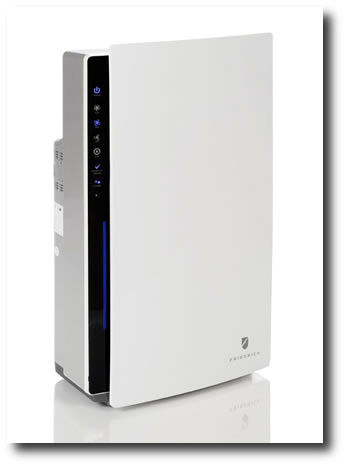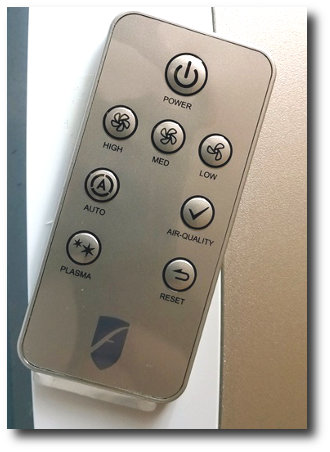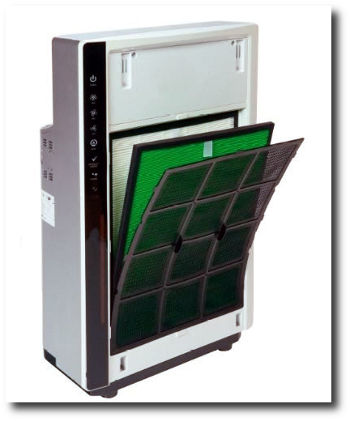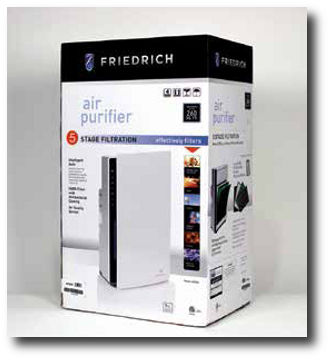Friedrich AP260 Air Purifier Review
Friedrich AP260 Review
In the spring of 2014, Friedrich Air Conditioning returned to the residential air quality market with a new product, their AP260 air purifier.Friedrich AC is a privately-owned San Antonio-based air conditioning company.
Back in 2005, electrostatic precipitators were the dominant air purifier technology, HEPA filtered machines sold slower.
Leaders Sharper Image (Ionic Breeze) and Oreck controlled more than half the growing market with infomercial sales pitches focused on "never buying filters."
Since Friedrich's main business was concentrated in the summer months, they designed an air purifier, the Friedrich C90, around existing AC parts and a much more powerful electronic grid than the over-marketed leaders.
Building the C90 in the AC off season kept the San Antonio workers busy, and the product was a success in spite of what I then called an "industrial aesthetic."
Friedrich's first effort looked exactly like a bunch of AC engineers drew it up in their spare time, the best analogy for C90's appearance is the pet transporter box used to carry or ship medium sized pets on aircraft.
But the ugly duckling had a strong fan and achieved Clean Air Delivery Rates (CADRs) near the top of the scale.
Friedrich's sales got a big boost when Consumer Reports (CR) named the C-90B a "Best Buy."
At that point, air-purifier-power.com and other industry voices raised concerns about ozone emissions from the electrostatic grids, which were very prone to sparking and arcing.
CR caught on and blasted Sharper Image and Oreck for poor performance and significant ozone outputs in their tests.
By 2007, CR was incorrectly calling the ozone-producing electronic precipitators "ionizers," and publicly traded Sharper Image was in play by big money - Wall Street short sellers.
Suddenly somebody noticed Consumer Reports former top pick, Friedrich C90, was slightly ozone-prone.
According to company literature from that period, the Friedrich C-90A Electronic Air Cleaner produced between .005 and .020 parts per million (ppm) of ozone, far lower than the leading competitors.
An industry shakeout, the "ozone panic," ensued, just as Friedrich, the last AC builder to retain US production, was forced to move the air conditioning production line to Mexico.
C90 didn't make the trip, production was halted.
Eventually ozone standards were adopted by the Air Resources Board, and ironically set high enough (.050 ppm) to include several survivors with ozone levels far above the extinct Friedrich.
To family-owned Friedrich's credit, they never stopped supporting the old C90, many of which still run today.
In the ensuing years, most air purifier production has been outsourced to China.
It looks like the new Friedrich AP260, introduced in the spring of 2014, is designed in, and imported from, China.

Selling for around $235.00, AP260 has little in common with the old Friedrichs.
In contrast to C90's utilitarian appeal and work-horse power, the AP260 is a sleek-looking, fully automated, mid-powered, modern air cleaner.
Friedrich AP260 "5-Stage" Air Purifier has no electrostatic grid, it relies on a series of filters and a dual-polarity plasma streaming ionizer.
Principal competitors for AP260 are Winix Plasmawaves, Sharp Plasmaclusters, and Fellowes PlasmaTrues.
No new air cleaner takes off quickly in today's overbuilt market, but the new AP260 has been picked up by several online vendors, including Sylvane.com and Amazon.com.
After a couple months on the market, the new Friedrich's sales rank number 47 in the HEPA Air Purifiers category at Amazon.
Friedrich AP260 Reviews
A couple bloggers have written up the AP260, but there are no "professional" reviews of the Friedrich as of May 2014.Amazon has 48 user reviews, averaging 4.5 stars.
Automation
The first thing to notice about the reintroduced Friedrich is AP260's completely automated controls.A vertical touch-panel runs the full height on the right edge, offering intuitive touch-sensor buttons.
Friedrich's Air Quality Sensor measures and displays the status of room air quality on a long vertical LED display.
When Auto Mode is selected, the fan will speed up as pollutants are detected.
User reviews suggest AP260 is pretty good at sensing both odors and particles;
"cooking will cause it to turn red,"

"cat stirs up the sand in her box,"
"dog sitting near,"
"neighbor lights cigarette,"
"vacuum cleaner running."
Note that many air purifier users are naively running dangerously leaky vacuum cleaners (even some with "HEPA" stickers pasted on) which are often the worst polluters in homes without smokers or heavy chemical use.
A handy remote control features the same options as the front panel.
Friedrich AP260 has a magnetic niche on the rear to prevent losing the remote, a very common issue, especially when users move to new lodging.
There is a light sensor which modulates a night dim/quiet feature.
I warn buyers of automated air purifiers NOT to rely exclusively on Auto Mode.
For best results ALL air purifiers should run on HIGH speed, (used as the sole basis for CADR and Room Size ratings discussed below), for a few hours daily, especially before bed time.
CADR
A mid-powered Air Purifier, AP260 is AHAM Verified for Clean Air Delivery Rates as follows;| Dust | 175 |
| Pollen | 176 |
| Smoke | 168 |
AHAM (Association of Home Appliance Manufacturers) uses a multiple of the CADR to set room size recommendations.
Shoppers will see Friedrich AP260 recommended as suited to "spaces up to 260 square feet."
While this is not as excessive as some other brand's claims, I recommend a maximum room size of 200 square feet, small and mid-sized rooms, for the new Friedrich, assuming the plasma streamer is kept running.
Users who may be sensitive to the oxidants and wish to turn off the plasma stream when near the AP260 should lower room size expectations to 170 square feet.
AP260 Filter Train
A common theme in air purifier designs coming out of Asia is "multiple stages" of filtration.This notion is quite easy to sell to stateside rebranders and vendors.
Now I am a staunch advocate of extensive prefiltering ahead of HEPA filters.
But many consumers are being fooled by "more stages mean better efficiency" and extra jargon when what they are getting is a filter pack, and sometimes UV lamps, to buy frequently.
Friedrich AP260 has four filters and a plasma ion streamer.
First in the Friedrich AP260's stack is a permanent washable fiberglass coarse dust prefilter.
Many consumers overlook the value of this permanent filter, which is frequently omitted in
low-cost designs.

Second is an antibacterial-antifungal filter, all the rage since the SARS scare in China a few years back.
My opinion is on the record: air purifiers are useful, but most likely will NOT protect households from the spread of emerging diseases, which tend to spread by touch and close coughing.
Next in sequence is a True HEPA filter.
My suspicion that product development for the new Friedrich was completely outsourced comes from the error in the HEPA specification - an extra decimal place uniformly repeated across the web, likely originating in the Chinese marketing brochure.
Astute readers will notice: "High Performance HEPA filter captures up to 99.97 Percent of all particles as small as .03 microns" is incorrect.
HEPA filters are judged by their ability to retain particulate at three-tenths micron, that's .3 NOT .03.
I also dislike the awkward marketing slogans, probably provided by the offshore source.
"4X more filter surface area than popular brands" is meaningless.
"4,700 square inches of filter media surface area" probably means all 4 filters, and in the US we measure filters by the square foot - "33 sq. ft." just doesn't give the same impression.
"Enhanced HEPA filter" probably refers to anti-bacterial additives to retard microorganism growth, but exactly what additives?
Some user reviews suggest weak filter seals;
"... gasket around the main HEPA filter is not tightly pressed up against the plastic..."
This may allow unfiltered air to bypass the main HEPA filter.
The carbon odor filter appears to carry under a pound of filter material, with component mixture unspecified.
I'd say AP260's designers are relying on the plasma streamer to deal with chemicals and odors.
Filter Replacement
Friedrich estimates average carbon/multi-filter replacement intervals at 6-8 months, and HEPA annually.Smoking households will need much more frequent carbon filter changes, and some very tidy folks may get a year of filter life.
This is a serious cost center - 2 filters to replace twice a year, and one annually.
User reviews say the filter exchange is nearly effortless and straightforward, with color-coded filters and tabs.
The filter kit, Friedrich AP260HFRK, is $70 with carbon, multi-filter, and HEPA.
Friedrich AP260CFRK Annual Carbon Filter Replacement Kit for AP260 runs $83.
Some user reviewers have expressed concern for the future availability of filters.
In my experience, it is purifiers which rarely need replacements that dealers refuse to keep stocked.
And, Friedrich still offers replacement pre and post filters for the long gone C90's.
Friedrich Plasma Ionizer
There is much shopper and user confusion over this new plasma streamer.Ever since Consumer Reports incorrectly used the term "ionizer" to derrogate then-popular but dangerous ozone-spewing electrostatic precipitators (Ionic Breeze, Oreck XL), consumers still exhibit confusion.
Historically, "ionizer" properly referred to negative ion generators (single polarity negative only), hardly a threat to anyone.
Friedrich AP260 is a dual polarity plasma-streamer, a newer type of oxidizing air cleaner.
Plasma streamers, pioneered by the hugely successful Sharp Plasmaclusters, generate both positive and negative ions.
These ions attack airborne water vapor molecules, creating hydroxyl radicals, powerful oxidizers that can DESTROY odors and chemicals in the air.
Unfortunately, the new Friedrich's plasma ionizer receives little emphasis in manufacturer and vendor literature.
Factory reps have assured me this is NOT a rebranded Winix Plasmawave like several competing brands offer.
Since some users may be sensitive to the oxidizers (I rarely run my Sharp or Winix streamers when sitting near), a positive feature of the new Friedrich is that the AP260's plasma generator can be turned off easily.
I have noticed that plasma streamers, particularly the Winix models, can sometimes seem too weak for strong pollutant loads like incoming wood stove smoke.
So a stronger streamer would be a good selling point - I have hoped somebody would introduce a stronger plasma streamer.
In fairness to Sharp Electronics, originator of the plasma ionizer, they do offer some dedicated (filterless) more powerful Plasmaclusters.
Several users say the Friedrich AP260 "ionizer" can be noisy, especially when atmospheric moisture levels or airborne dust are elevated.
Sharp Plasmaclusters are known for a clicking sound, and Winix Plasmawave has also drawn some noise feedback, although my Winix is very quiet.
Noise-sensitive individuals may complain, but a recurrent theme with plasma ion streamers, even with the best-selling Plasmaclusters, has been "How can we tell if it's even working?"
Data is scarce, but smoking users mention AP260's VISIBLE effects on cigarette smoke, suggesting a strong plasma generator setup.
Numerous user reviews describe the Friedrich streamer sound as a "squeaking fan," while others say "escaping steam."
To me this is a consumer misunderstanding - I advocate keeping plasma ionizers off until a scent or fume is present, or some time has passed, and then running the streamer while away from the machine.
Used in this way, as opposed to "always on," the streamer does its job, users will KNOW it is working, and the noise will be a moot issue.
Emissions
While plasma streamers create negligible ozone, many users do not realize the possible danger of chronic close exposure to the oxidizers from contemporary plasma streamers.Sharp's Plasmacluster has sold something like 40,000,000 units without a single injury claim due to health effects.
But I still warn sick or sensitive users to avoid prolonged direct exposure to the streamer, which, I consider unnecessary anyhow, except perhaps when the user is a cigarette smoker who cannot go outside.
Friedrich AP260 draws few noise complaints, though a few mention "louder on high."
Unfortunately the manufacturer has not provided actual verifiable decibel readings.
Air purifier designers just can't seem to grasp the idea that bedrooms need to be almost pitch dark for effective melatonin (sleep hormone) production.
Further, it is wavelengths in the blue area of the spectrum, 460 to 480nm, which suppress melatonin synthesis most.
So naturally what color should the lights on nearly every air purifier be?
Blue, of course.
So it's no surprise that the new Friedrich's blue LED's are too bright.
Users express irritation, saying the blue light can only be turned off when auto mode is off.
Although there is a "night mode" with lower light emissions, some users mention turning the AP260 around.
This is not unusual, all three of my bedroom air cleaners have lights taped or covered, I'd just hoped someday they'd stop designing new units with this old problem.
Lastly, there are some chemically sensitive users who have noticed plasticizer emissions from the cord.
Keeping plasticizer feeds at a standard, safe level, has been an engineering problem ever since plastic injection molding was invented.
I am hearing more and more of these complaints as offshored manufacturing has taken over.
So I must add Friedrich AP260 to the list of air cleaners "not recommended for the chemically sensitive" (MCS).
Utility: Energy Use and Portability
Friedrich AP is EPA ENERGY STAR qualified, with a decent 3.1 Dust CADR per Watt.Using only 8W on Low, 15W on Medium, 56W on High, and 2W on standby, AP260's effects on the electric bill should be moderate.
Measuring 7.8 x 15 x 26.5 inches, a typical rectangular air cleaner, AP260 weighs just over 18 pounds.
A molded in slot on the back makes the Friedrich easy to carry from room to room.
A common mistake by air cleaner buyers is "buying without measuring the room."
Friedrich AP260's 6.25 foot power cord could be a bit longer where power outlets are sparse.
Upward directed airflow allows some flexibility in location choice for AP260, as compared to round or lateral flow competitors.
Corporate and Warranty
Friedrich Air Conditioning is a privately held company that has built commercial-grade room air conditioners, operating in San Antonio since 1883.With their previous air purifier product, Friedrich established a good reputation, despite the product's utilitarian aesthetic.
AP260 is covered by a warranty of up to five years on functional parts and one year labor when customer delivers to service center.
This old line family owned company backed previous products well, and users are quite positive about Friedrich's customer service for the new AP260.
Based in the USA, these folks will answer the phone.
Conclusions
PROS
aesthetically more appealing than older Friedrich modelslow power consumption
old line family-owned company has reputation to protect
good customer service reputation
possible strong plasma ionizer
CONS
outsourced product very similar to competitionshort filter life
multiple filters to replace
lower power - 175 CADR - than some
Not Recommended For
chemically sensitive usersrooms over 200 sq. ft.
Judgment
With a new product in today's very difficult market, I never know what the outcome will be.
Other popular models that have gone off the market, like Rabbit Air BIOGS, have had trouble regaining market share.
So time will tell if Friedrich can build market with the AP260.
The most interesting thing about the new Friedrich is the possibility of a more powerful plasma streamer.
But there is really no metric for measuring the real world performance on odor and chem pollutants, only user reports of satisfaction, always subjective.
With the AP260, it is the company's long time reputation I like, the product is very similar to established brands Sharp Plasmacluster
and Winix Plasmawave, and many rebranded versions of the Winix.
The Friedrich AP260 5-Stage Air Purifier
is available at Amazon.com.
Site Navigation
End Friedrich AP260 Air Purifier Review, go to Home Page
